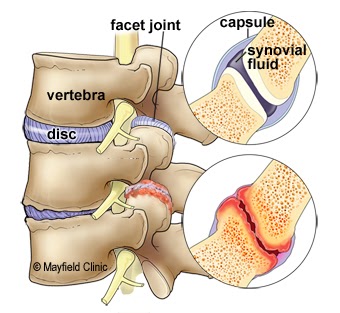
Facet Syndrome
Facet Syndrome is a series of similar complaints stemming from irritation of facets joints: small capsular joints at the back of the spine. Facet syndrome can be a acute short term condition or advance into a chronic condition known as Degenerative Joint Disease (DJD). Facet syndrome is more common is young athletes or individuals with poor core strength.
The anatomical structure involved in DJD is the facet joint. There are 2 facet joints at each level in the spine that allow the vertebrae to move within 6 different ranges of motion. The facet joints are synovial joints filled with synovial fluid and surrounded by ligamentous tissue. When there is an increase in pressure on the facet joints by postural changes that cause the weight of the spine to be forced posterior off of the discs, as is seen in an increased lumbar curvature or hyperlordosis, bone will start to grow bone spurs as a means to increase stability and help distribute the weight.
Bone spurs can push on the nerve roots which travel directly below the joint causing some nerve irritation or pressure. Now we may have some referred pain that accompanies spine pain.
The first thing we want to do is work on increasing motion at the joint in combination with decreasing inflammation. Part of the pain source has to do with the joint being restricted in motion, so this is why increasing mobility will be the main form of pain relief. Then the focus will be on corrective exercise to help change the weight distribution back to the disc to remove the pressure on the joints. Again, treatment isn’t going to reverse the bony changes that have already occurred, but treatment can prolong the mobility of the joint and slow the progression of degeneration.
